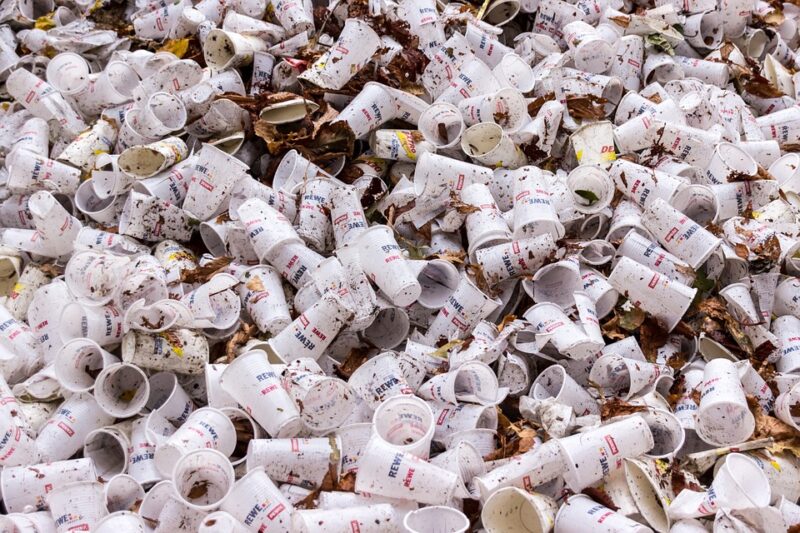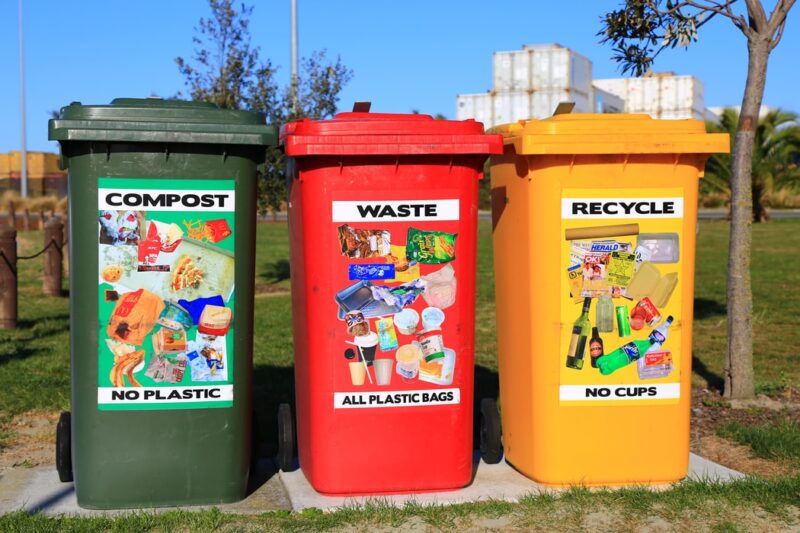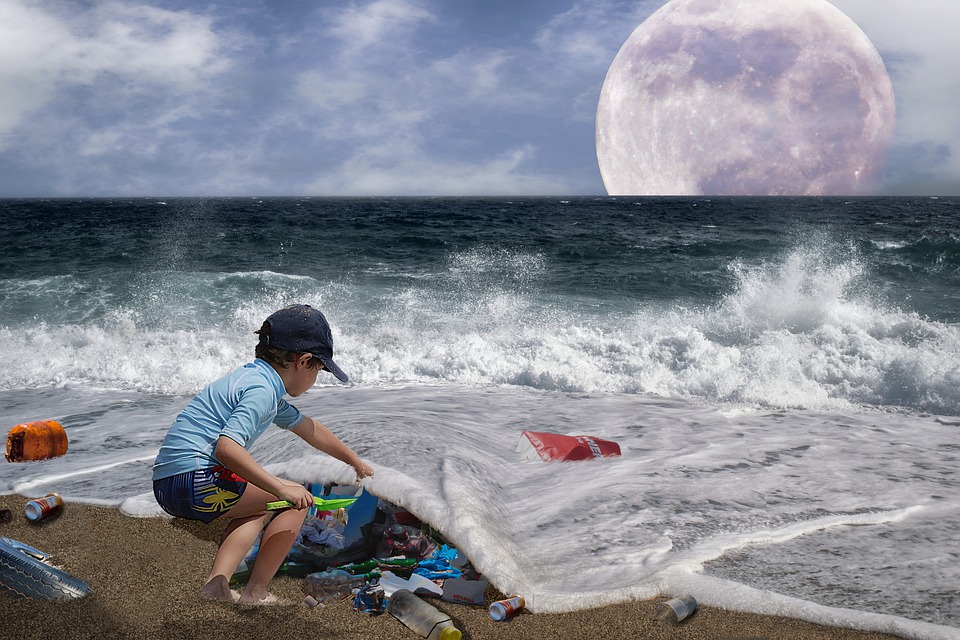Image by Maja7777
Heal the Bay Intern, Yamileth Urias, explores the nuances of a classic environmental slogan.
As children, we are taught to reduce, reuse, and recycle. At some point in our lives, many forget about the first two R’s, reduce and reuse, and mostly rely on the last R– recycle. As plastic pollution becomes an increasingly alarming issue, we must not forget to reduce and reuse. Here is why that order matters.
How is plastic produced and why should we be worried?
We consume food and water in containers made from fossil fuels! Yes, that’s right. Plastic is made from oil and natural gas. Through polymerization, resins are created, which allows plastics to be molded and shaped under heat and pressure. This video further explains the plastic production process.
Oil and gas industries have only become more powerful in the last century since fossil fuels are crucial in the creation of plastics. Not only do we rely on oil and gas companies for transportation, energy, and heating, but also plastic. However, the fossil fuel industry has encountered a challenge — electric vehicles and renewable energy resources like solar power. As we become more aware of the exploitation of natural resources like fossil fuels, we have made changes to remedy the situation. With the rise of electric and hybrid vehicles and alternative energy sources, the demand for fossil fuel has decreased, causing oil and gas industries to turn to and invest more in new plastic production. New plastic production is cheaper than using recycled plastics due to weakened oil prices. According to a study by Carbon Tracker, the oil industry plans to spend $400 billion on new plastic and less than $2 billion in reducing plastic waste over the next five years.
The drastic gap in investments in virgin plastic and effort to reduce plastic waste has created a monster that is becoming more difficult to control. Corporations are producing more plastic despite knowing that most of it will not be recycled. According to a 2017 study, we have created 6.3 billion tonnes of plastic waste since 1950. Only 10% of all plastic waste has ever been recycled. This means that over 90% of plastic produced is waste that ends up polluting our environment, our water, and eventually items we consume. This is why using recycling as our only means to fight plastic pollution simply will not work.
Recycling allows for the continued creation of plastics. The best solution is to reduce plastic use in order to stop the harmful effects plastic has on us, our communities, and the environment. We need a permanent solution that will help us transition from relying on plastic to drastically reducing our plastic use.

Image by meineresterampe
Reduce first!
There are several issues with recycling.
- There is simply too much plastic produced and we cannot recycle our way out of it. A significant amount of this plastic is single-use plastic that cannot be recycled. 99% of cutlery and plastic plates do not meet the standards to be recycled.
- Most of the items we try to recycle are not recycled. Studies have found that only 9% of all plastics produced are recycled.
- Plastics are not infinitely recyclable. They are downcycled, meaning it cannot be made into the same thing, unlike glass and aluminum. Each time material is repurposed, it becomes a lower quality that will eventually lose its ability to be recycled.
For these reasons, the best solution is to reduce our plastic use. One of the best ways is to reduce the use of single-use plastics. Out of approximately 9.2 billion tonnes of plastic produced, 40% are single-use products like plastic bags and cutlery. By reducing our use of plastic, we also reduce the demand for it. In order to fully make our efforts effective, we must reduce our individual plastic-use and pressure companies to change their harmful practices.
Reuse materials around the home
Our lives are not completely plastic-free. We all have plastic items in our homes, and the pandemic has only increased our plastic use. That is okay! If you must use packaging or single-use products, you can always choose a more eco-friendly option that is biodegradable. This includes FSC-certified paper, wheat straw or locally-sourced materials.
However, that may not always be an option. It is also important to point out that sustainable products can be expensive. Not everyone can afford to keep buying $50 reusable bottles and filters because the water in their neighborhood is not safe to drink. This is why reusing is the next best action to partake in. You can continue with your plastic-reduction efforts by reusing and repurposing plastics you currently own before disposing of them. This can be done by using a plastic tub of butter to store other food items in your fridge. Another popular usage for plastic containers includes storing away things around your homes like a sewing kit or hair ties and pins. Other items like old toothbrushes can be used as tools to clean hard-to-reach surfaces. There are many ways to get creative and upcycle plastic products you currently own.
Recycle when there is no other alternative
Simply because there are better alternatives to recycling does not mean that we should stop all recycling efforts. According to a study by Pew Trusts, the plastic in our oceans is expected to nearly triple from 11 million tonnes to 29 million tonnes in the next 20 years. Plastic pollution has rapidly increased over the years and it will only get worse in the next couple of decades. This means that over the next 20 summers, oceans will become increasingly more polluted affecting wildlife and the coastal environment as we know it. The plastic pollution crisis is so big that any effort is better than no effort.
It is also important to point out that the world is a unique situation that has disrupted plastic reduction efforts. People all over the world increased their plastic use due to the COVID-19 pandemic. COVID-19 briefly helped the environment by reducing transportation emissions, but it also caused long-term damages with the massive increase in plastic use. Consumption of single-use plastic increased somewhere between 250-300% during COVID-19. Almost 30% of this spike in single-use plastic is attributed to personal protective equipment (PPE). There is nothing wrong with being cautious and looking out for one’s health, so if reducing or reusing plastic is not an option, the next best thing is to recycle when possible. With that in mind, it is crucial to practice plastic reduction efforts in a hierarchical order. Click here for more ideas on how to reuse and recycle items around your home.

Image by Nareeta Martin
What you can do to help
One simple way to reduce plastic use starts with takeout. Next time you are ordering takeout, consider requesting no plastic cutlery or drinking your beverage without a straw and using utensils from home instead. You can also take action by supporting the takeout extras on-request initiative. Due to COVID-19, takeout orders have increased and so has the use of single-use plastic. Sign the petition asking legislators to support #SkipTheStuff. You can also take action by sending an email to DoorDash to #CutOutCutlery. Through this campaign, we can encourage food delivery apps to change their default plastic cutlery option and move to a request-based option.
For more guidance on how you can repurpose and recycle items around your home, conduct a waste audit. This guide on waste audits is the perfect way to reevaluate your home waste, plastic usage and find creative ways to repurpose items. It’s the perfect activity just in time for spring cleaning that will also keep you busy during the quarantine.
About the author
Yamileth is a graduating senior at the University of Southern California studying public relations and political science. Her internship with Heal the Bay communications encompasses branding, research and social media. Growing up in a coastal town sparked her passion for environmental conservation, environmental justice and marine life protection. In her free time, she enjoys experimenting with recipes, gardening and sewing.



